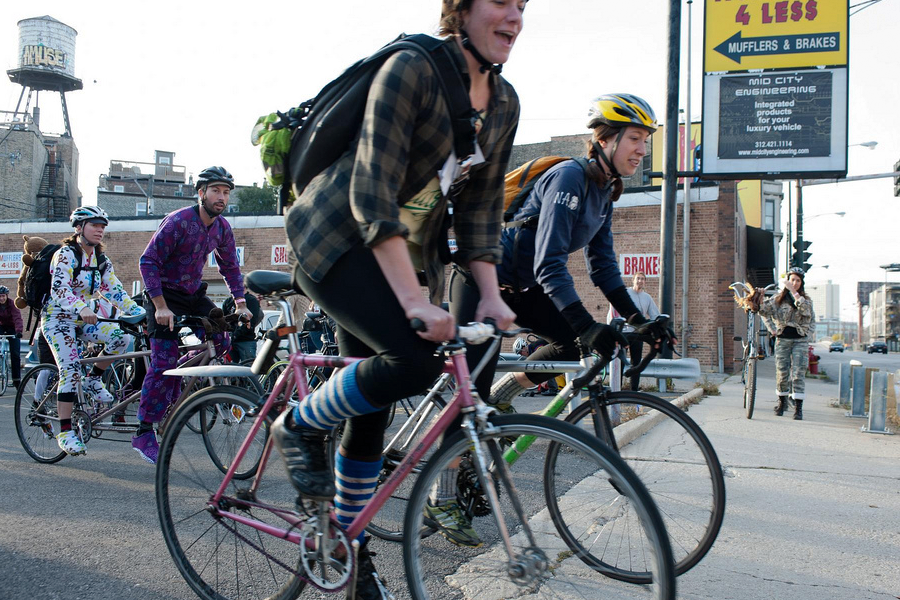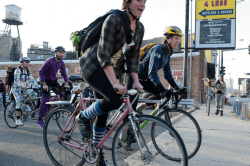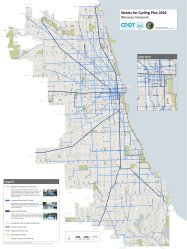Look over your shoulder, Portland, Minneapolis, and Washington, D.C. Chicago is about to roll out plans to lay down 645 miles of bike lanes by 2020. If you’re not careful, the Windy City is going to pedal off with the title of Most Bikeable City in the U.S.
Today, the city’s bike-loving mayor, Rahm Emanuel, will unveil the Streets for Cycling Plan 2020, an aggressive bicycling blueprint that was a year in the making. With 30 miles of protected bike lanes already completed and another 70 promised before the end of Emanuel’s first term in 2015, the city’s new cycling infrastructure will weave through every neighborhood, assuring a path within a half-mile of every Chicagoan’s home.
The unveiling takes place on Chicago’s once taxi-, auto-, and bus-infested Dearborn Street. The city spawned a wave of envy among national bike bloggers this month when it removed a motor vehicle lane from the downtown artery, replacing it with a two-way protected cycling lane complete with bike traffic signals.
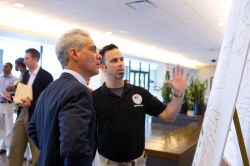
Chicago Mayor Rahm Emanuel and bike czar Gabe Klein.
Michael Amsden, a project manager for the Chicago Department of Transportation (CDOT) Bike Program says swiping a lane from drivers took “lots of political know-how,” adding that “no other city has cut through dense traffic” in that manner. While other cities have been putting in bike infrastructure for years, what sets Chicago apart, Amsden says, is the sheer super-speed at which the city has laid down protected bike lanes, going from “zero to second-most in the country in just 18 months.” City officials hint that converting car lanes into bike lanes is the way of Chicago’s future.
The mastermind of all this action is Chicago transportation czar Gabe Klein, known for cruising town on his Dutch-style two-wheeler sporting vintage linen suits. In many areas of the city, Klein says, lane installation is tied with planned infrastructure improvements, which will make the work less expensive. And while initial funding for the project is local, next year the city will work with federal funds awarded through the Congestion Mitigation and Air Quality program.
But the plan’s strongest asset, say supporters, is its backing from the public: It’s a grid designed by the people for the people. To create it, CDOT teamed up with the Active Transportation Alliance, a local nonprofit advocacy group that set up community meetings in nine areas of the city. Alliance volunteers met monthly for a year with residents in neighborhood bars, restaurants, and homes to discuss where they wanted to see the bike lanes installed. Major obstacles included the city’s numerous rail lines, waterways, and high-crime areas. Large maps detailing the routes were delivered to CDOT engineers.
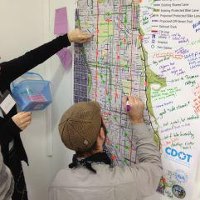
“To my knowledge,” says Lee Crandell, the Alliance’s director of campaigns, “no other city has involved the public as much as Chicago has.”
Klein hopes to see the number of cars on the roads — and their speed — decrease. (According to the 2010 census, only 1.3 percent of Chicagoans bike to work, but studies show more would if they felt safe.) Future engineering includes more pedestrian crosswalks, bus-only lanes, and digital speed signs for motorists along busy thoroughfares. Over time, Amsden envisions the Windy City becoming less frenetic as the “Mary Poppins Effect” kicks in – that is, as racing bikes and Spandex give way to more casual cruisers and street clothes.
“When motorists see someone dressed in their work clothes riding a bike with a bell and a basket, while sitting upright, they seem to slow down because the cyclist’s look calls for respect,” Amsden says. “Drivers in Amsterdam, for example, know how to drive next to a person on a bicycle.”
There’s been little opposition to Emanuel’s quest to transform Chicago’s driving habits. One of the few outspoken critics is John Kass, a plump (“readers tell me that bicycling to work would seriously improve the sculpt of my buttocks”), car-driving Chicago Tribune columnist who has often painted cyclists and their protected lanes as either hipsters or snobs. When Emanuel gushed about progressive transportation and the need for sustainability in times of environmental shifts, Kass wailed that bike riders are the “One Percenters of the Commuter Class.”
“We thought we’d be able to get through the summer without reading a nakedly antagonistic-to-bicyclists story,” moaned a writer on the Chicagoist blog. “Leave it to Tribune curmudgeon John Kass to piss in our Corn Flakes yet again.”
Pete Scales, spokesman for CDOT, estimates the city spent $4 million on the 30 miles built in 2012. City Hall considers it a small investment with a large return. Bike lanes, Emanuel and Klein believe, will attract new and young entrepreneurs and high-tech companies to Chicago.
Crandell adds that studies have proven that bike lanes help fuel the local economy. “It is said that the faster a credit card goes by your door, the less likely it is that card will be used in your store,” he explains. “When someone is on a bike, they can just pull over, hop off, and park. And biking creates more bike-related businesses.”
Last year Bike Magazine listed Chicago as the 10th most friendly city for riding. This year it rose to No. 5. CDOT hopes that the Dearborn improvements will put the city in the lead. But can Emanuel really make good on such ambitious promises, given Americans’ love affair with the automobile? Word is that in Emanuel-speak, he’s f#!*ing determined.
“I’m a big believer in getting things done versus talking about them,” says Klein. “So is the mayor. We have a moral responsibility to make change as soon as possible.”

